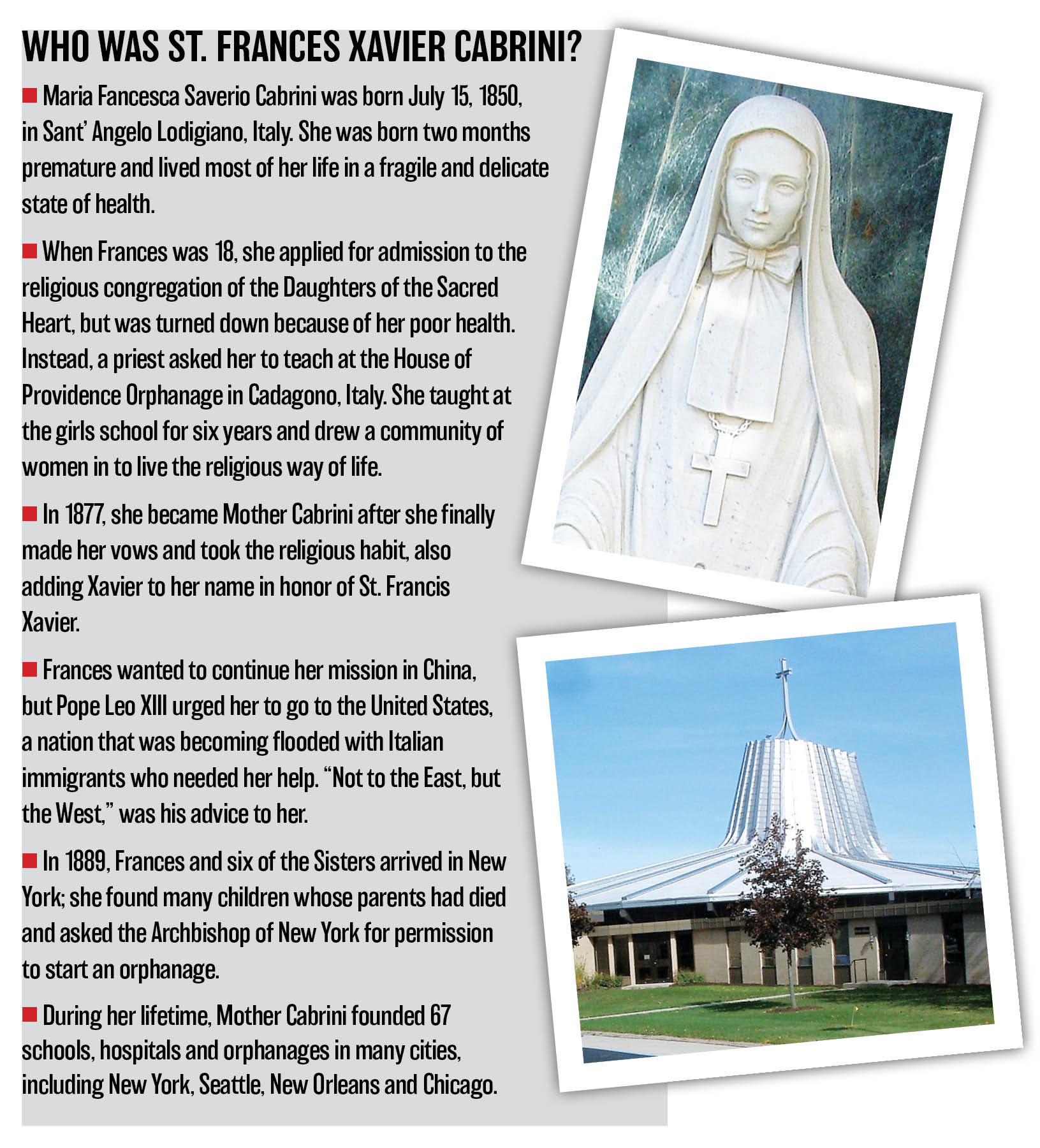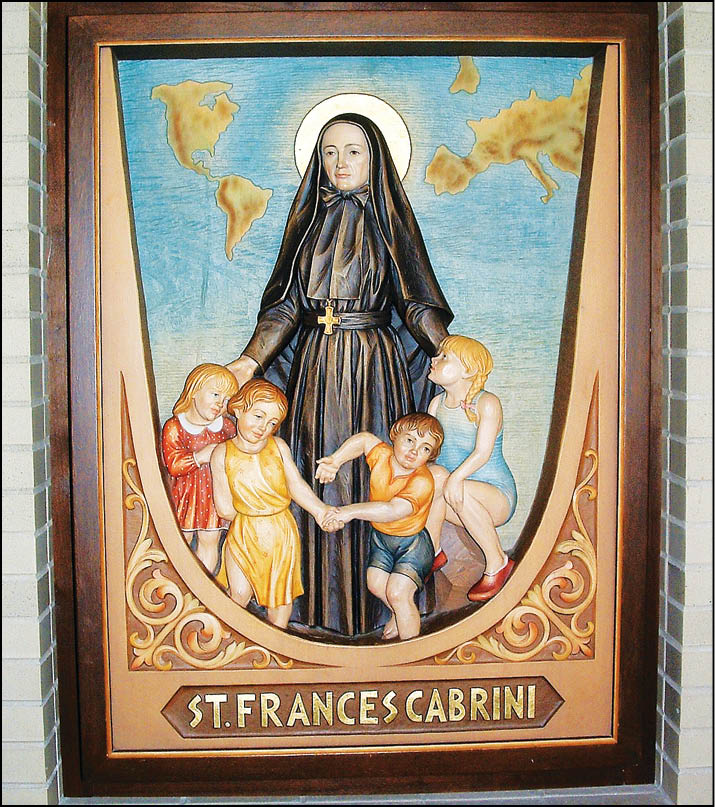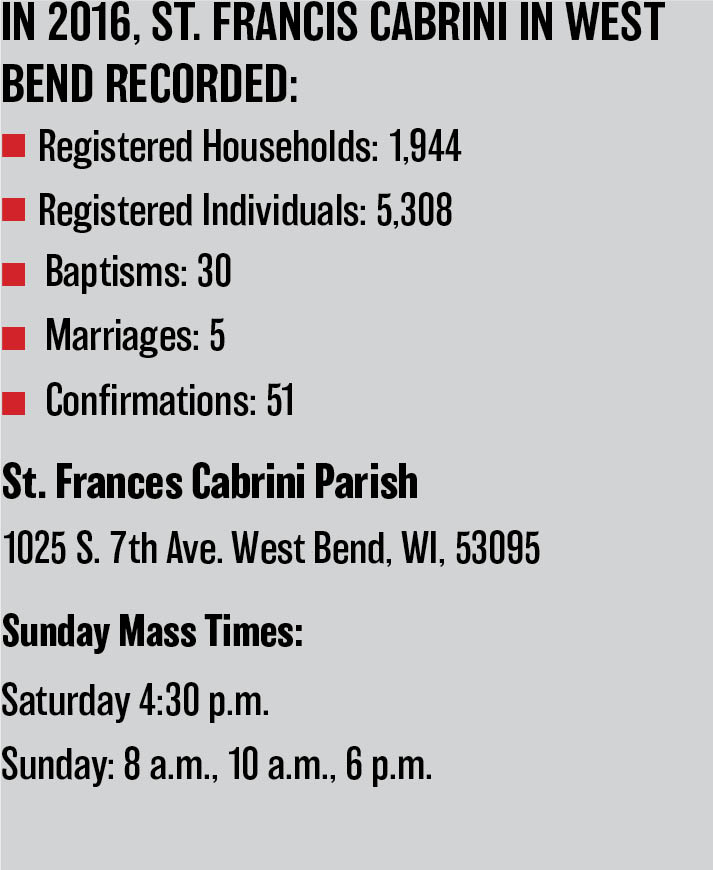It’s a place of worship offering a warm, comforting blend of the old and the new.

Top: A marble statue of St. Frances Cabrini. Above: The entrance to St. Frances Cabrini Parish. (Photos by Tom Andrews)
Its familiar traditional Catholic church feel is accented by a spacious, contemporary seating area. The sanctuary is surrounded by beautiful stained-glass windows with modern design. This is a church well-prepared to attract and meet the diverse spiritual needs of a growing congregation that features people of all ages and backgrounds.
Welcome to St. Frances Cabrini Parish in West Bend, a church canonically established by the Archdiocese of Milwaukee on May 23, 1955. Its patron saint, Maria Francesca Saverio Cabrini, was chosen for her life of outreach, service to the poor and education of children. Her legacy lives on and inspires parishioners of all ages.
As visitors pull into the church parking lot, it’s impossible to miss the shiny steel cross tower rising above the church roof. A statue of Mother Cabrini graces the main entrance.
“When it was built, it was billed in the archdiocese as this cutting edge, really modern place to pray and worship with its layout and orientation,” said Fr. Nathan Reesman, pastor of St. Frances Cabrini since 2011. “Part of the main feature with the swooping, dramatic ceiling over the altar is this upward movement to God. It’s supposed to be this kind of a lifting up of us into the heavens with the real focus on the altar of sacrifice. So it’s a very warm space to pray in with everyone seated close within the sanctuary. It’s nice to preach in and I think it contributes to the community feel of the place.”
On July 3, 1955, a group of 420 members met for the first time as a new Christian community in the gymnasium of McLane School on Chestnut Street. The gym would serve as the church for the next 26 months while the children attended Holy Angels School. The dramatic growth this new church community would experience was officially underway.
Following a three-year fundraising drive that yielded $250,000, ground was broken for a new school Sept. 9, 1956. The school was dedicated the next year and on Oct. 7, 1958, groundbreaking ceremonies were held for a new parish convent. The sisters took up temporary residence in a house at 610 W. Hawthorne St., and once the new convent was completed, the house became the rectory for nine years. The year 1959 would bring a dedication ceremony for the parish convent and rectory while about 400 children were enrolled at the parish school.
As more families joined the parish, it became clear the school would have to be enlarged. A new school addition was dedicated Sept. 30, 1962. Five years later, on May 9, 1967, St. Frances Cabrini parish had groundbreaking ceremonies for a new church and rectory. The first Mass was celebrated in the new church on Palm Sunday, 1969.

A photo of St. Frances Cabrini hangs on the wall of her namesake parish in West Bend. (Tom Andrews photo)
And still the church continued to grow. Next, changes were made to give it a more contemporary look. In 1978, stained-glass windows were installed around the perimeter of the church at a cost of approximately $36,000. Beyond the aesthetics, the church designers had a larger purpose.
“The windows were clear glass until the late 1970s or early 80s, and the stained glass was added later,” Fr. Reesman explained. “They are intentionally a mix of the old and modern because they have an older look of stained glass to them but the ‘modern’ is that they are a modern rendition of the life of Christ though there’s actually a code throughout all of the windows. Throughout the circular body of the church that they encompass, they mirror each other almost exactly, the idea being that our life is always to mirror Christ’s.
“One half of each window is Christ’s life and the other is our life. So it’s His baptism, His transfiguration, His passion, His resurrection and His encounters with the Apostles. You can understand the story if you know the code. There are some people in the parish who are quite proud of that part of our heritage (the code) and they have this information in pamphlets and will give you a little tour to walk around and point out the different parts of it.”On July 3, 2005, parish membership was at 2,115 families consisting of 5,640 individuals when Archbishop Timothy M. Dolan celebrated a Jubilee Mass marking 50 years of St. Frances Cabrini parish life. It’s a parish life that today’s members, young and old, have come to deeply appreciate.
“We have a rich worship experience,” said Andrew Kolb, a member of St. Frances Cabrini virtually his whole life and, at age 26, he serves as chair of the Parish Council. “We have a good staff that puts together good, strong liturgies. The music is good and pertains well to the readings for each week. We have a great pastor in Fr. Nathan, and Fr. Justin both do a great job putting together a reverent liturgy for us. They both have good voices so when they sing during  the Mass it adds nicely, too. The thing I like best about the liturgy is people who are there, the families with everyone singing along and involved as full participants in the Mass.”
the Mass it adds nicely, too. The thing I like best about the liturgy is people who are there, the families with everyone singing along and involved as full participants in the Mass.”
“At St. Frances Cabrini parish, worship these days is right down the middle of mainstream Catholic Archdiocesan life,” said Fr. Reesman. “There’s nothing really too traditional and nothing too contemporary, either. There’s a balance of both. We have a full Mass schedule here with some of the Masses lean more towards the classical and one Mass that’s more contemporary but it’s not dramatically so.
“Our people pray and participate well. They listen well and are very attentive. It’s a worship space with a lot of life in it in terms of kids and special needs people who are most welcomed. I would say it’s a very hospitable place to come and pray.”
As it is with churches in general, bringing younger people into the fold presents its own special challenges. Through his work on the Parish Council and interaction in the community, Kolb accepts that challenge as a way strengthen his own faith while spreading spiritual influence to those he meets.
So what’s in store for this parish’s future? Fr. Reesman optimistically sees even more opportunity for Christian outreach.
“The mission that I see is to learn how we can keep being the (West Bend) community’s parish by reaching out to neighborhoods to the school, aged families in the area and those who are poor in town. There are many who need our assistance. We have to keep reaching out and putting ourselves on the edge of our comfort zone and say ‘We want to invite you into the church to encounter Christ and to pray with us and be with us.’”
